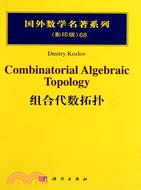組合代數拓撲(簡體書)
商品資訊
ISBN13:9787030313836
出版社:科學出版社
作者:DMITRY KOZLOV
出版日:2017/12/21
裝訂:精裝
規格:26cm*19cm (高/寬)
商品簡介
目次
相關商品
商品簡介
本書書是Springer的AlgorithmsandComputationinMathematics叢書系列第21卷,作者多年來從事離散數學,代數拓撲,理論計算機科學。組合代數拓撲是代數拓撲和離散數學的交叉。屬于“反映學術前沿進展的優秀學術著作”這一類。比較專門,本書的讀者可以是幾何,拓撲和代數方向的數學工作者和研究生。
目次
1 overture part i concepts of algebraic topology 2 cell complexes 2.1 abstract simplicial complexes 2.1.1 definition of abstract simplicial complexes and maps between them 2.1.2 deletion, link, star, and wedge 2.1.3 simplicial join 2.1.4 face posets 2.1.5 barycentric and stellar subdivisions 2.1.6 pulling and pushing simplicial structures 2.2 polyhedral complexes 2.2.1 geometry of abstract simplicial complexes 2.2.2 geometric meaning of the combinatorial constructions 2.2.3 geometric simplicial complexes 2.2.4 complexes whose cells belong to a specified set of polyhedra 2.3 trisps 2.3.1 construction using the gluing data 2.3.2 constructions involving trisps 2.4 cw complexes
.2.4.1 gluing along a map 2.4.2 constructive and intrinsic definitions 2.4.3 properties and examples 3 homology groups 3.1 betti numbers of finite abstract simplicial complexes 3.2 simplicial homology groups 3.2.1 homology groups of trisps with coefficients in 252 3.2.2 orientations 3.2.3 homology groups of trisps with integer coefficients. 3.3 invariants connected to homology groups 3.3.1 betti numbers and torsion coefficients 3.3.2 euler characteristic and the euler-poincard formula 3.4 variations 3.4.1 augmentation and reduced homology groups 3.4.2 homology groups with other coefficients 3.4.3 simplicial cohomology groups 3.4.4 singular homology 3.5 chain complexes 3.5.1 definition and homology of chain complexes 3.5.2 maps between chain complexes and induced maps on homology 3.5.3 chain homotopy 3.5.4 simplicial homology and cohomology in the context of chain complexes 3.5.5 homomorphisms on homology induced by trisp maps 3.6 cellular homology 3.6.1 an application of homology with integer coefficients: winding number 3.6.2 the definition of cellular homology 3.6.3 cellular maps and properties of cellular homology 4 concepts of category theory 4.1 the notion of a category 4.1.1 definition of a category, isomorphisms 4.1.2 examples of categories 4.2 some structure theory of categories 4.2.1 initial and terminal objects 4.2.2 products and coproducts 4.3 functors 4.3.1 the category cat 4.3.2 homology and cohomology viewed as functors 4.3.3 group actions as functors 4.4 limit constructions 4.4.1 definition of colimit of a functor 4.4.2 colimits and infinite unions 4.4.3 quotients of group actions as colimits 4.4.4 limits 4.5 comma categories 4.5.1 objects below and above other objects 4.5.2 the general construction and further examples 5 exact sequences 5.1 some structure theory of long and short exact sequences. 5.1.1 construction of the connecting homomorphism 5.1.2 exact sequences 5.1.3 deriving long exact sequences from short ones 5.2 the long exact sequence of a pair and some applications 5.2.1 relative homology and the associated long exact sequence 5.2.2 applications 5.3 mayer-vietoris long exact sequence 6 homotopy 6.1 homotopy of maps 6.2 homotopy type of topological spaces 6.3 mapping cone and mapping cylinder 6.4 deformation retracts and collapses 6.5 simple homotopy type 6.6 homotopy groups 6.7 connectivity and hurewicz theorems 7 cofibrations 7.1 cofibrations and the homotopy extension property 7.2 ndr-pairs 7.3 important facts involving cofibrations 7.4 the relative homotopy equivalence 8 principal f-bundles and stiefel-whitney characteristic classes 8.1 locally trivial bundles 8.1.1 bundle terminology 8.1.2 types of bundles 8.1.3 bundle maps 8.2 elements of the principal bundle theory 8.2.1 principal bundles and spaces with a free group action 8.2.2 the classifying space of a group 8.2.3 special cohomology elements 8.2.4 z2-spaces and the definition of stiefel-whitney classes 8.3 properties of stiefel-whitney classes 8.3.1 borsuk-ulam theorem, index, and coindex 8.3.2 stiefel-whitney height 8.3.3 higher connectivity and stiefel-whitney classes 8.3.4 combinatorial construction of stiefel-whitney classes. 8.4 suggested reading part ii methods of combinatorial algebraic topology 9 combinatorial complexes melange 9.1 abstract simplicial complexes 9.1.1 simplieial flag complexes 9.1.2 order complexes 9.1.3 complexes of combinatorial properties 9.1.4 the neighborhood and lovasz complexes 9.1.5 complexes arising from matroids 9.1.6 geometric complexes in metric spaces 9.1.7 combinatorial presentation by minimal nonsimplices. 9.2 prodsimplicial complexes 9.2.1 prodsimplicial flag complexes 9.2.2 complex of complete bipartite subgraphs 9.2.3 horn complexes 9.2.4 general complexes of morphisms 9.2.5 discrete configuration spaces of generalized simplicial complexes 9.2.6 the complex of phylogenetic trees 9.3 regular trisps 9.4 chain complexes 9.5 bibliographic notes 10 acyclic categories 10.1 basics 10.1.1 the notion of acyclic category 10.1.2 linear extensions of acyclic categories 10.1.3 induced subcategories of cat 10.2 the regular trisp of composable morphism chains in an acyclic category 10.2.1 definition and first examples 10.2.2 functoriality 10.3 constructions 10.3.1 disjoint union as a coproduct 10.3.2 stacks of acyclic categories and joins of regular trisps 10.3.3 links, stars, and deletions 10.3.4 lattices and acyclic categories 10.3.5 barycentric subdivision and a-functor 10.4 intervals in acyclic categories 10.4.1 definition and first properties 10.4.2 acyclic category of intervals and its structural functor 10.4.3 topology of the category of intervals 10.5 homeomorphisms associated with the direct product construction 10.5.1 simplicial subdivision of the direct product 10.5.2 further subdivisions 10.6 the msbius function 10.6.1 msbius function for posets 10.6.2 msbius function for acyclic categories 10.7 bibliographic notes 11 discrete morse theory 11.1 discrete morse theory for posets 11.1.1 acyclic matchings in hasse diagrams of posets 11.1.2 poset maps with small fibers 11.1.3 universal object associated to an acyclic matching. 11.1.4 poset fibrations and the patchwork theorem 11.2 discrete morse theory for cw complexes 11.2.1 attaching cells to homotopy equivalent spaces 11.2.2 the main theorem of discrete morse theory for cw complexes 11.2.3 examples 11.3 algebraic morse theory 11.3.1 acyclic matchings on free chain complexes and the morse complex 11.3.2 the main theorem of algebraic morse theory 11.3.3 an example 11.4 bibliographic notes 12 lexicographic shellability 12.1 shellability 12.1.1 the basics 12.1.2 shelling induced subcomplexes 12.1.3 shelling nerves of acyclic categories 12.2 lexicographic shellability 12.2.1 labeling edges as a way to order chains 12.2.2 el-labeling 12.2.3 general lexicographic shellability 12.2.4 lexicographic shellability and nerves of acyclic categories 12.3 bibliographic notes 13 evasiveness and closure operators 13.1 evasiveness 13.1.1 evasiveness of graph properties 13.1.2 evasiveness of abstract simplicial complexes 13.2 closure operators 13.2.1 collapsing sequences induced by closure operators 13.2.2 applications 13.2.3 monotone poset maps 13.2.4 the reduction theorem and implications 13.3 further facts about nonevasiveness 13.3.1 ne~reduction and collapses 13.3.2 nonevasiveness of noncomplemented lattices 13.4 other recursively defined classes of complexes 13.5 bibliographic notes 14 colimits and quotients 14.1 quotients of nerves of acyclic categories 14.1.1 desirable properties of the quotient construction 14.1.2 quotients of simplicial actions 14.2 formalization of group actions and the main question 14.2.1 definition of the quotient and formulation of the main problem 14.2.2 an explicit description of the category c/g 14.3 conditions on group actions 14.3.1 outline of the results and surjectivity of the canonical map 14.3.2 condition for injectivity of the canonical projection. 14.3.3 conditions for the canonical projection to be an isomorphism 14.3.4 conditions for the categories to be closed under taking quotients 14.4 bibliographic notes 15 homotopy colimits 15.1 diagrams over trisps 15.1.1 diagrams and colimits 15.1.2 arrow pictures and their nerves 15.2 homotopy colimits 15.2.1 definition and some examples 15.2.2 structural maps associated to homotopy colimits 15.3 deforming homotopy colimits 15.4 nerves of coverings 15.4.1 nerve diagram 15.4.2 projection lemma 15.4.3 nerve lemmas 15.5 gluing spaces 15.5.1 gluing lemma 15.5.2 quillen lemma 15.6 bibliographic notes 16 spectral sequences 16.1 filtrations 16.2 contriving spectral sequences 16.2.1 the objects to be constructed 16.2.2 the actual construction 16.2.3 questions of convergence and interpretation of the answer 16.2.4 an example 16.3 maps between spectral sequences 16.4 spectral sequences and nerves of acyelic categories 16.4.1 a class of filtrations 16.4.2 m5bius function and inequalities for betti numbers 16.5 bibliographic notes part iii complexes of graph homomorphisms 17 chromatic numbers and the kneser conjecture 17.1 the chromatic number of a graph 17.1.1 the definition and applications 17.1.2 the complexity of computing the chromatic number 17.1.3 the hadwiger conjecture 17.2 state graphs and the variations of the chromatic number 17.2.1 complete graphs as state graphs 17.2.2 kneser graphs as state graphs and fractional chromatic number 17.2.3 the circular chromatic number 17.3 kneser conjecture and lovasz test 17.3.1 formulation of the kneser conjecture 17.3.2 the properties of the neighborhood complex 17.3.3 lovasz test for graph colorings 17.3.4 simplicial and cubical complexes associated to kneser graphs 17.3.5 the vertex-critical subgraphs of kneser graphs 17.3.6 chromatic numbers of kneser hypergraphs 17.4 bibliographic notes 18 structural theory of morphism complexes 18.1 the scope of morphism complexes 18.1.1 the morphism complexes and the prodsimplicial flag construction 18.1.2 universality 18.2 special families of hem complexes 18.2.1 coloring complexes of a graph 18.2.2 complexes of bipartite subgraphs and neighborhood complexes 18.3 functoriality of horn (-, -) 18.3.1 functoriality on the right 18.3.2 aut (g) action on horn (t, g) 18.3.3 functoriality on the left 18.3.4 aut (t) action on horn (t, g) 18.3.5 commuting relations 18.4 products, compositions, and horn complexes 18.4.1 coproducts 18.4.2 products 18.4.3 composition of horn complexes 18.5 folds 18.5.1 definition and first properties 18.5.2 proof of the folding theorem 18.6 bibliographic notes 19 characteristic classes and chromatic numbers 19.1 stiefel-whitney characteristic classes and test graphs 19.1.1 powers of stiefel-whitney classes and chromatic numbers of graphs 19.1.2 stiefel-whitney test graphs 19.2 examples of stiefel-whitney test graphs 19.2.1 complexes of complete multipartite subgraphs 19.2.2 odd cycles as stiefel-whitney test graphs 19.3 homology tests for graph colorings 19.3.1 the symmetrizer operator and related structures 19.3.2 the topological rationale for the tests 19.3.3 homology tests 19.3.4 examples of homology tests with different test graphs 19.4 bibliographic notes 20 applications of spectral sequences to horn complexes 20.1 horn+ construction 20.1.1 various definitions 20.1.2 connection to independence complexes 20.1.3 the support map 20.1.4 an example: hom+(cm, kn) 20.2 setting up the spectral sequence 20.2.1 filtration induced by the support map 20.2.2 the 0th and the 1st tableaux 20.2.3 the first differential 20.3 encoding cohomology generators by arc pictures 20.3.1 the language of arcs 20.3.2 the corresponding cohomology generators 20.3.3 the first reduction 20.4 topology of the torus front complexes 20.4.1 reinterpretation of h*(a*t, d1) using a family of cubical complexes {φm,n,g } 20.4.2 the torus front interpretation 20.4.3 grinding 20.4.4 thin fronts 20.4.5 the implications for the cohomology groups of hom (cm, kn) 20.5 euler characteristic formula 20.6 cohomology with integer coefficients 20.6.1 fixing orientations on horn and horn+ complexes 20.6.2 signed versions of formulas for generators [as] 20.6.3 completing the calculation of the second tableau 20.6.4 summary: the full description of the groups h* (hom (cm, kn); z) 20.7 bibliographic notes and conclusion references index
主題書展
更多
主題書展
更多書展今日66折
您曾經瀏覽過的商品
購物須知
大陸出版品因裝訂品質及貨運條件與台灣出版品落差甚大,除封面破損、內頁脫落等較嚴重的狀態,其餘商品將正常出貨。
特別提醒:部分書籍附贈之內容(如音頻mp3或影片dvd等)已無實體光碟提供,需以QR CODE 連結至當地網站註冊“並通過驗證程序”,方可下載使用。
無現貨庫存之簡體書,將向海外調貨:
海外有庫存之書籍,等候約45個工作天;
海外無庫存之書籍,平均作業時間約60個工作天,然不保證確定可調到貨,尚請見諒。
為了保護您的權益,「三民網路書店」提供會員七日商品鑑賞期(收到商品為起始日)。
若要辦理退貨,請在商品鑑賞期內寄回,且商品必須是全新狀態與完整包裝(商品、附件、發票、隨貨贈品等)否則恕不接受退貨。
























